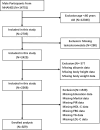Association of geriatric nutritional risk index with total testosterone in elderly adults in the US: evidence from NHANES 2011-2016
- PMID: 39736863
- PMCID: PMC11682979
- DOI: 10.3389/fendo.2024.1457956
Association of geriatric nutritional risk index with total testosterone in elderly adults in the US: evidence from NHANES 2011-2016
Abstract
Background and objectives: There is growing evidence that deficiencies in specific nutrients can impact testosterone levels in older men. However, research examining the predictive value of overall nutritional status on testosterone levels remains limited. The Geriatric Nutritional Risk Index (GNRI) is an effective tool for assessing the nutritional status of the elderly. Therefore, this study aimed to investigate the potential correlation between the GNRI and serum total testosterone (TT).
Methods: A representative sample of U.S. males aged 60 years and older who participated in the National Health and Nutrition Examination Survey (NHANES) cycles from 2011 to 2016 was utilized for this cross-sectional study. The research included a total of 829 older adults. Tandem mass spectrometry and liquid chromatography were employed to quantify TT. To examine the association between GNRI and TT, restricted cubic splines (RCS) and weighted multivariate regression analyses were conducted. Subgroup analysis was performed to identify the variables influencing the positive association between GNRI and TT. Additionally, a sensitivity analysis was carried out to compare the weighted and unweighted data.
Results: After adjusting for all other factors, a positive association was found between GNRI and TT. The beta coefficient was 5.59, with a 95% confidence interval of 2.16 to 9.01, and a p-value of 0.003. Compared to the lowest quartile of GNRI (Q1), the second quartile (Q2), third quartile (Q3), and fourth quartile (Q4) significantly increased the level of TT. The beta coefficients for Q2, Q3, and Q4 were 70.15 (p = 0.022), 104.40 (p < 0.001), and 84.83 (p < 0.001), respectively. In subgroup analyses, statistically significant associations were observed among participants who did not have diabetes, had hypertension, and had a BMI of 24.9 or less. According to the sensitivity analysis, unweighted data also found GNRI to be associated with TT (beta = 3.09, P = 0.031).
Conclusion: A positive correlation was identified between the GNRI and TT in the elderly male population of the United States. Further prospective studies with larger sample sizes are needed to confirm the causal relationship between GNRI and TT.
Keywords: Geriatric Nutritional Risk Index; NHANES database; men’s health; older adults; serum total testosterone.
Copyright © 2024 Li, Jiang, Liang, Li, Li, Huang and Wang.
Conflict of interest statement
The authors declare that the research was conducted in the absence of any commercial or financial relationships that could be construed as a potential conflict of interest.
Figures


Similar articles
-
Nonlinear Association Between Geriatric Nutritional Risk Index and Cardiovascular Disease in the Elderly Based on the NHANES Database.Int Heart J. 2025 Jan 31;66(1):13-20. doi: 10.1536/ihj.24-232. Epub 2025 Jan 17. Int Heart J. 2025. PMID: 39828338
-
Impact of the Geriatric Nutritional Risk Index on short-term prognosis of patients with sepsis-related acute kidney injury: analysis using the MIMIC-IV database.BMC Nephrol. 2025 Apr 23;26(1):205. doi: 10.1186/s12882-025-04122-2. BMC Nephrol. 2025. PMID: 40269775 Free PMC article.
-
Association between geriatric nutritional risk index and depression prevalence in the elderly population in NHANES.BMC Public Health. 2024 Feb 14;24(1):469. doi: 10.1186/s12889-024-17925-z. BMC Public Health. 2024. PMID: 38355455 Free PMC article.
-
Association between geriatric nutritional risk index and cognitive function in older adults with/without chronic kidney disease.Brain Behav. 2024 Sep;14(9):e70015. doi: 10.1002/brb3.70015. Brain Behav. 2024. PMID: 39262164 Free PMC article.
-
Geriatric nutrition risk index in the prediction of all-cause and cardiovascular mortality in older adults with hyperlipidemia: NHANES 1999-2018.BMC Geriatr. 2024 Jul 27;24(1):634. doi: 10.1186/s12877-024-05232-6. BMC Geriatr. 2024. PMID: 39068440 Free PMC article.
References
MeSH terms
Substances
LinkOut - more resources
Full Text Sources

